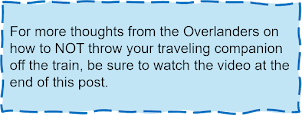There had been minimal friction during their first few days of traveling. Thanks to their close friendship in college, they were already well-acquainted with each other's more irritating quirks: Jim's introverted stubbornness, Tom's extroverted impulsiveness. While in England, nothing gave rise to any differences of opinion or preference, as Jim’s brother and sister-in-law put them up in their home, fed them, and made all decisions on where to go and what to see—and then took them there.
Things began to change on the London-Oostende-Copenhagen leg of the journey. They now needed to make all decisions about food, lodging, and how to spend their days. On the train to Dover, the ferry to Oostende, and then on to Copenhagen, Tom spent a lot of time with his nose deep inside “Let’s Go Europe.” He read passages about the city’s history and its most famous landmarks—aloud and often—while Jim half-listened, watching the scenery pass by. Tom would suggest a place to stay and some sites to visit, and after some back-and-forth, they came to an agreement. But then Tom would read about another hostel or pensione and another “must-see,” and the decision-making process would start all over again. Jim admired his friend’s insatiable curiosity but felt bombarded by too many options. He knew that decisions had to be made, but he felt that once they agreed, it was time to close the travel guide and move on.They eventually agreed on a place to stay in Copenhagen: Hotel Absolom (now defunct and not to be confused with the luxurious Hotel Abasolon). It was a small room with a tiny window, twin beds, and a sink. The Water Closet was down the hall and shared with everyone else on the floor. A shower was nowhere to be found. It was then time to decide what sites they would see. Tom’s bed was soon covered with street maps and notebooks as he busied himself with planning out the sequence of sites they’d visit in order to see as much as possible in the day and a half they’d allotted for the City of Spires—so named for its plethora of Medieval and Renaissance spire-inspired architecture. Finally, one of them suggested a guided city tour via bus—either Jim out of annoyance or Tom out of frustration in trying to put together an itinerary the two of them could agree on. The tour would break the daily budget they had set for themselves, but it would help them decide which sites to focus on the following day before catching an overnight train to Stockholm.
Among the highlights they passed: Tivoli
Gardens (the world’s second-oldest amusement park, closed for the season),
the Strøget (car-free, completely pedestrianized zone of five winding
streets right in the heart of city center), Nyhavn (colorful
300-year-old houses lining the harbor canal, along with historical ships) the Rosenborg
Castle (the first of too many, as far as Jim was concerned), and the famous
statue of the Little Mermaid (perhaps the most disappointing tourist
site they would visit anywhere, situated on the least inspiring vista of the
harbor and under the constant and creepy attentions of male tourists
picture-posing for friends/wives.)
When the tour ended,
Jim suggested ducking into a bar for their first European beer. Tom
enthusiastically agreed and reached for his Let’s Go.
“No!” Jim said,
maybe louder than he’d intended. “There’s a bar right across the street. We
don’t need Let’s Go’s approval. Let’s live dangerously.”
The Lions
Club was all but empty. Taking a seat at the bar, Tom ordered a Carlsberg, Jim
a Tuborg. The bartender delivered both with a monotone, “Skål.” He knew a tourist
order when he got one.
Tom was
pumped from the tour. He pulled out a map, his journal, and a pen, and started
to list all the places they would visit the next day for a more “in-depth”
visit to selected sites that intrigued him during the tour. He also added sites that the guided tour hadn’t covered.
Jim was convinced that no human could visit all the sites Tom wanted
to see in a single day. He suggested maybe cutting out a site or two or five.
Tom agreed, but when he reworked his list and consulted Let’s Go, the
list somehow grew longer.
Not
wanting to dampen Tom’s enthusiasm, Jim grew quiet. And Tom, not wanting to
push his agenda on Jim, searched “Let’s Go” for more and more options he
thought might appeal to his friend. As they
talked, the bar started filling up with people. Someone started the jukebox.
Barry White’s bass-baritone made it difficult to hear Tom’s suggestions.
Finally,
Jim spoke up. “Binks, we need to figure out how we’re going to see what we want
to see without killing each other. We don’t have to check Let’s Go for
every decision. We should just let things happen and be more spontaneous, kind
of like we did for this place. Who knows? We might even meet some women
interested in meeting Americans.”
Tom nodded
enthusiastically. They both sat back and took a sip from their beers. During
their planning, the Lions Club had gotten crowded. Lots of laughing, loud
conversations, and even some dancing in front of the jukebox. The joint was
jumping, and Tom and Jim nodded to the beat of the music. And then they noticed
that the dancers—and everyone else in the bar—were men. Not a woman in sight. Tom
and Jim exchanged glances.
“Well,” Jim said. “I’m not suggesting we completely ignore Let’s Go.”
***
That was Then. Now for the NOW:
Reflections on "Signs of Strain"
Question from the Overlanders
What's your #1 strategy for ensuring that traveling with someone doesn't drive you or the other person crazy? Tell us about it! We'd love to hear from you. Put your answer--or any other reactions to this post--in the comments section below. And thanks for reading/watching!











